Last Updated on April 28, 2025 by Owen McGab Enaohwo
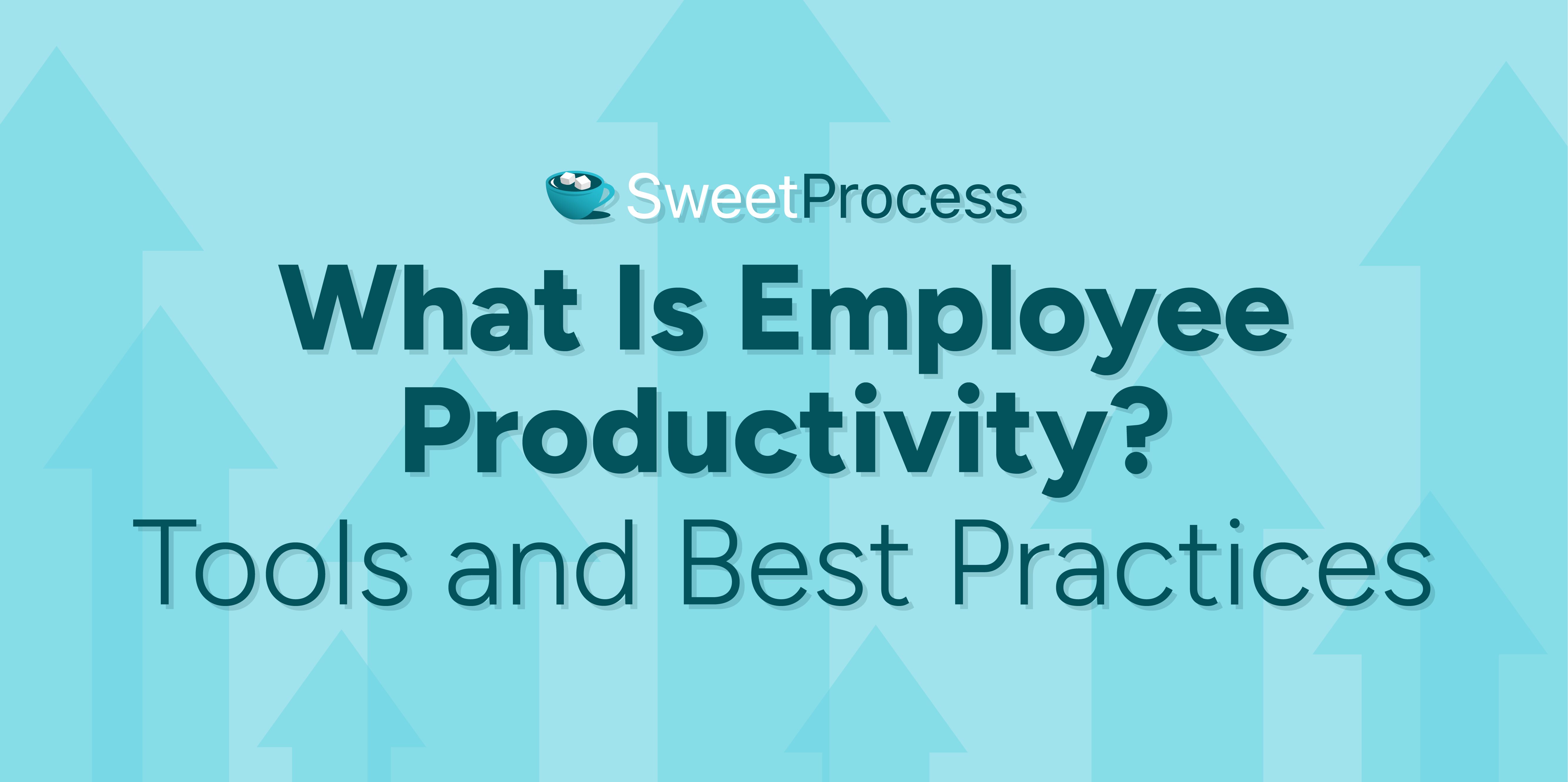
A happy team is essential to building a successful company. When employees have what they need to work efficiently, they are more likely to feel engaged and motivated to work well. And when they stay committed, you have a productive work environment.
But first of all, what does employee productivity even mean? And how do you engineer it all to boost your business growth? We’ll look into this and show you can improve it with the right strategies and tools that simplify the process for business growth.
Use SweetProcess to boost your employees’ productivity without stressing. You can try it for up to 14 days free. No credit card is required.
What You’ll Learn In This Guide:
What Is Employee Productivity?
Why Is Employee Productivity Important?
How to Improve Employee Productivity: Proven Strategies & Tips From Founders and Managers
How to Enhance Employee Productivity in the Workplace With SweetProcess
7 Employee Productivity Tools You Can Use in The Workplace
How to Measure Employee Productivity
7 Factors That Influence Employee Productivity
Unlock Your Team’s Potential Using SweetProcess
What Is Employee Productivity?

Employee productivity refers to the quantity and quality of work carried out by a company staff.
It’s more about collaborating with suppliers and team members, finishing up daily routines, meeting deadlines, and crushing targets while maintaining product or service quality.
Some examples include when a customer care support staff replies to several daily inquiries, addresses their concerns, answers their questions, and helps retain customers with buyer remorse or who are on the verge of switching to an alternative brand.
Why Is Employee Productivity Important?
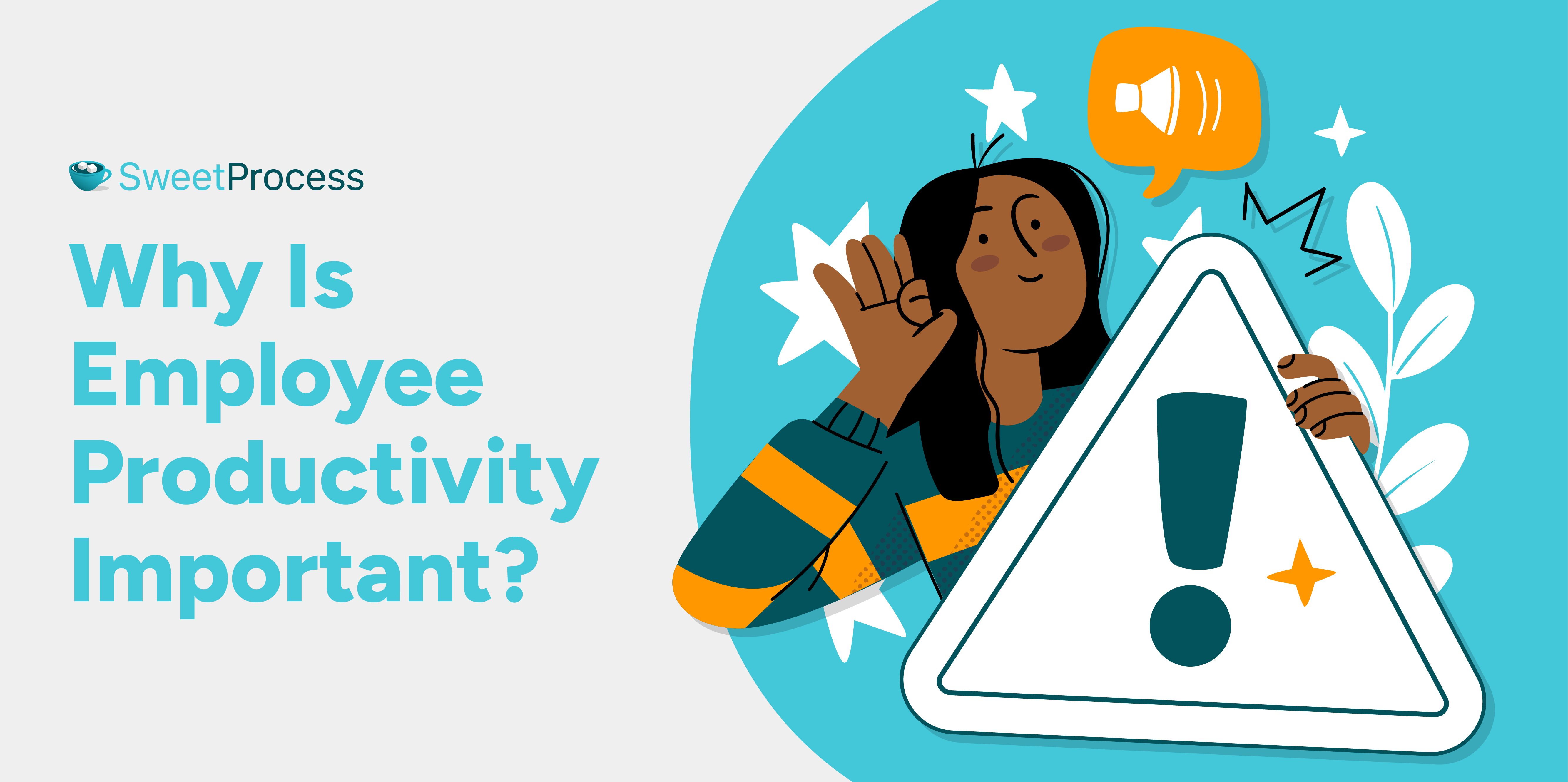
Here are some reasons why employee productivity is critical:
Impacts on Revenue and Growth
When employees are actively working, efficiency increases, and so does business revenue. It’s not surprising that a GoRemotely study shows that profits often rise by 21% due to engaged workforce productivity.
Boosts Employee Morale and Retention
It’s natural for anyone who finishes their duties to feel happy. When company staff finish their tasks, they feel motivated to do more. Motivated employees are productive employees with fewer missed deadlines and a high employee retention rate. Thus, your company saves costs that would’ve gone to training new workers.
Makes the Organization Competitive
Businesses with highly engaged staff are more likely to adapt to changing market conditions and often deliver quality work and services that meet customer needs while keeping up with trends. This is because highly engaged employees are more motivated to bring new ideas, take calculated risks, and be excellent. A company like Apple is driven by highly engaged employees who build outstanding devices that disrupt the smartphone market.
Helps Companies Meet Customer Demand
Productive workers help companies meet customer demand in different ways, like faster response times to customer inquiries, improved product quality, and proactive problem-solving. This enables you to build trust with customers, establish the company, and lead to loyal customers who want to do business with you for a long time.
How to Improve Employee Productivity: Proven Strategies & Tips From Founders and Managers
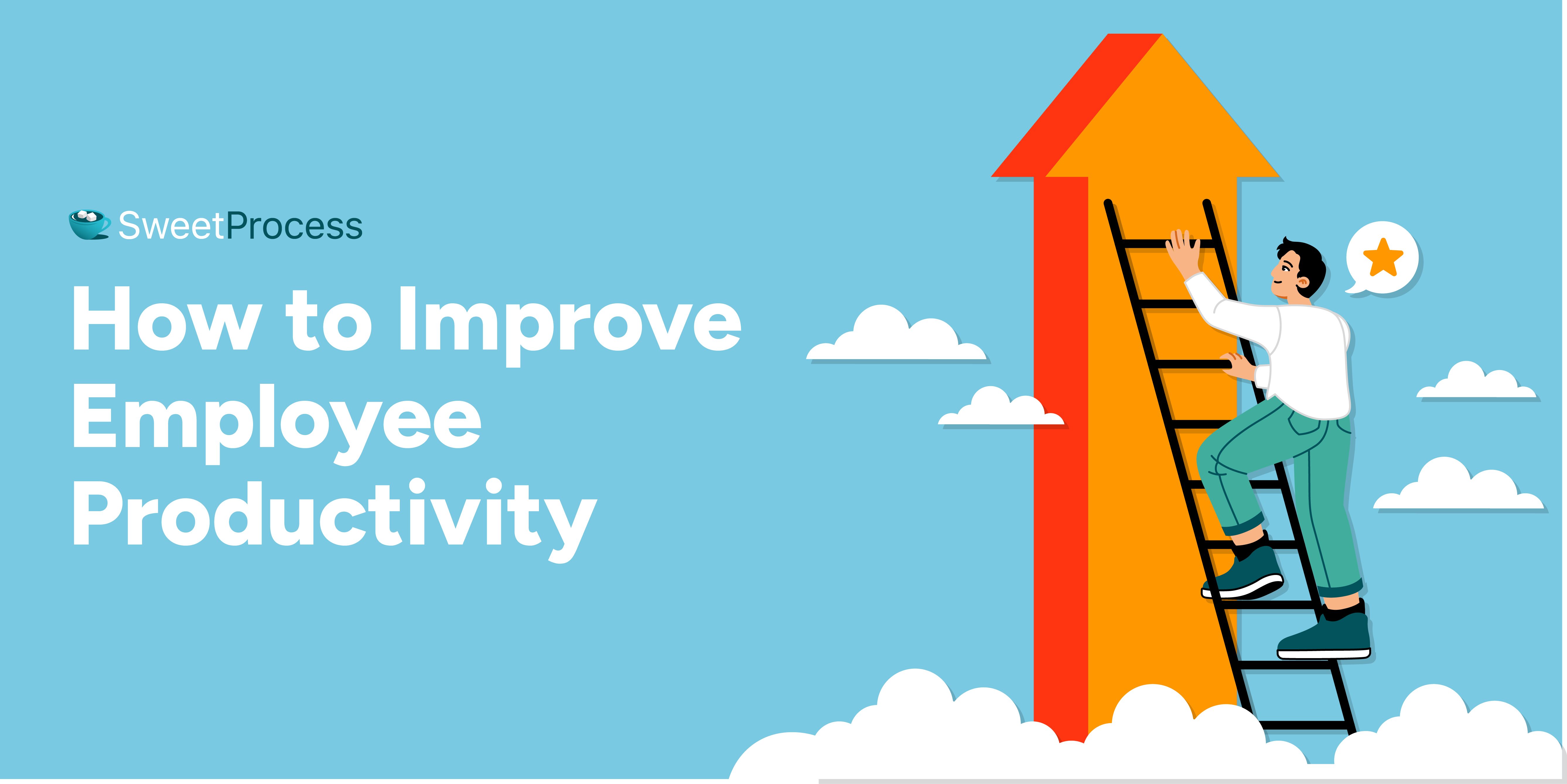
Set SMART Goals
Having smart, measurable, achievable, relevant, and time-bound (SMART goals) helps you boost your staff productivity levels. When there are specific and achievable goals, your staff can specifically dedicate their energy and time to what needs to be done. This way, they can easily stay motivated, measure progress, and adjust things where necessary.
Encourage Regular Feedback and Communication
Consistent feedback and communication are key to enhanced performance. When your workplace gives room for feedback, your team members can pinpoint their strengths and areas where they need to adjust, giving everyone clarity on what needs improvement. However, you may need to use an employee management tool like SweetProcess that allows for easy team collaborations and can enable you to utilize this strategy. There’s even a 14-day free trial that allows you to see how it works without any credit card required.
Provide Continuous Training and Development Opportunities
According to David Loo, the operations manager of Xpro Auto Glass:
“First, you should provide training programs to enhance skill sets and job satisfaction. When employees know their skills are improving, they feel more confident in their roles, and that confidence translates to better performance.”
That’s because when you spend money to sharpen your staff skills and experience, you give them the right knowledge and confidence to perform their duties. It’s also easy for them to adapt to any latest trends that meet customer expectations. Not just that, they are more likely to create better products and provide quality service to customers, leading to improved customer satisfaction. Integrating these training resources and policies into your employee handbook software ensures that employees can always access up-to-date development opportunities and guidelines.
Foster a Collaborative Work Environment
When there is collaboration in your workplace, team members share their thoughts and innovative ideas, giving you an edge over your competitors. This way, knowledge sharing, innovation, and mutual support among your staff will build trust, improve communication, strengthen their bonds, increase job satisfaction, and boost productivity.
Encourage Break Amidst Work
Just like Joe Bowab, the CEO and founder of Lobster Anywhere, said: “…we realized that our teams needed to be in a positive mental state in order…” So, we encourage employees to take regular breaks during the day to recharge and prevent fatigue from settling in.”
Working all the time does not necessarily speed up project completion. You need to give your employees rest time between tasks so they can stretch their bodies, walk around, and refresh themselves before continuing their tasks with renewed energy. This will also reduce burnout, increasing employee productivity and staff engagement.
Take out Unnecessary Meetings
Once you cut down on needless meetings, your free time and productivity go up by default. Most companies often hold too many meetings because they can’t share ideas effectively without hosting physical meetups.
Fortunately, a tool like SweetProcess can help you remove that burden. How? Many collaborative features allow you to ask questions and get feedback, create quizzes, and share videos, images, PDFs, voice notes, and documents to ensure everyone is on the same page.
Adopt the Use of Technology to Streamline Processes
“First, it’s about deciding what works best for your specific goals…. Another aspect is investing in tools that can eliminate or limit unnecessary, repetitive work.” —Mike Chappell, the co-founder and CEO of FormsPal.
When you use technology that streamlines employee workflows, you can easily automate routine tasks, streamline processes, enhance team productivity, and reduce manual work so you can focus on highly rewarding activities. A tech tool like SweetProcess can help you create and manage your business processes.
Use Time-Tracking Tools
Time-tracking tools can help your staff keep track of their work time, prioritize tasks, and stay focused. Leveraging time-tracking tools allows your team to manage their time better, reduce procrastination, and lead to high productivity. This way, you keep everyone accountable and motivated to do their duties and improve your business outcomes.
How to Enhance Employee Productivity in the Workplace With SweetProcess
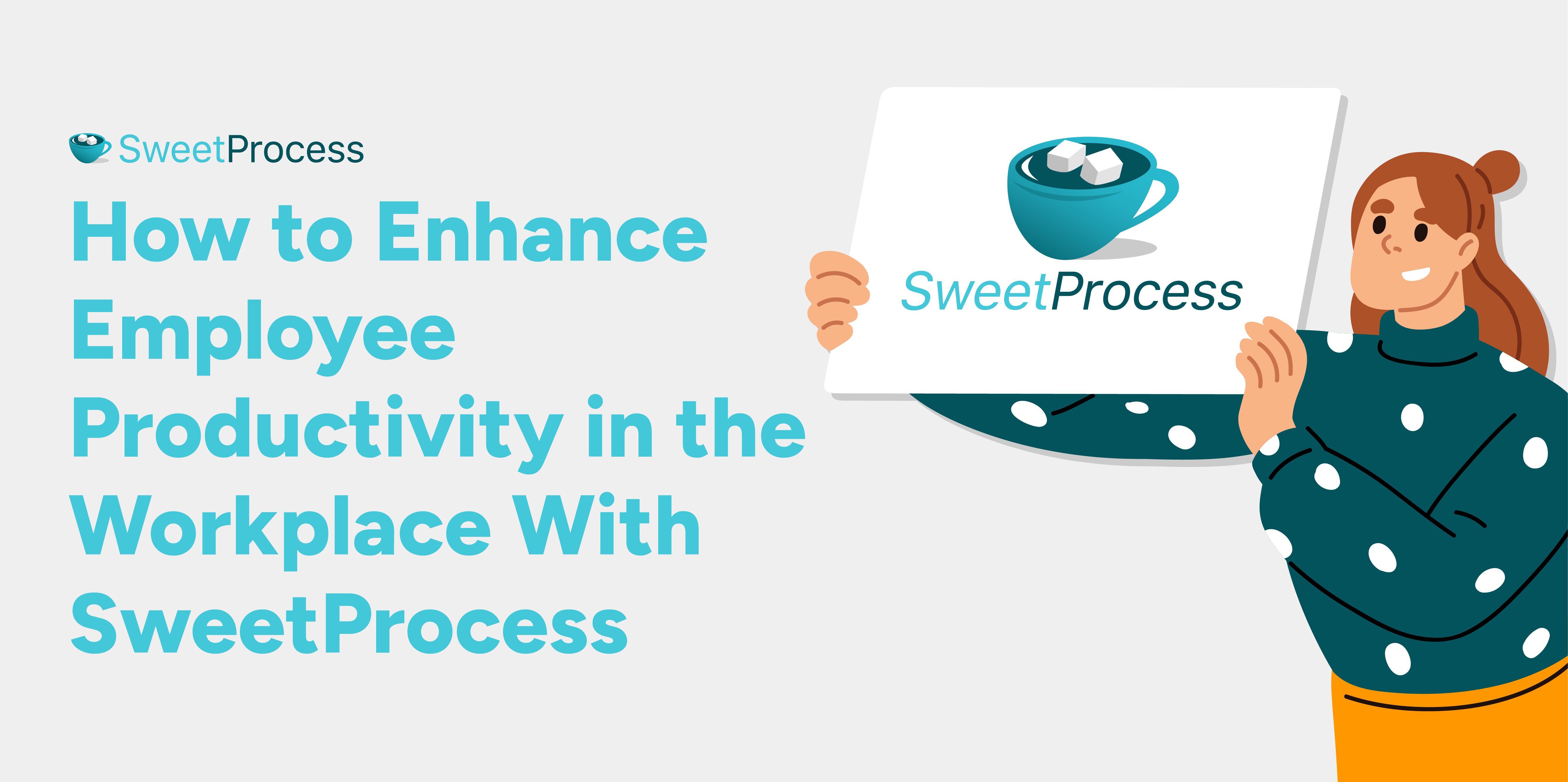
Document Repetitive Tasks in One Place
Identify tasks that are done regularly.
Go to the “Tasks” section.

Click “Assign Tasks” and select from your existing processes.

Select the team you want to assign it to.
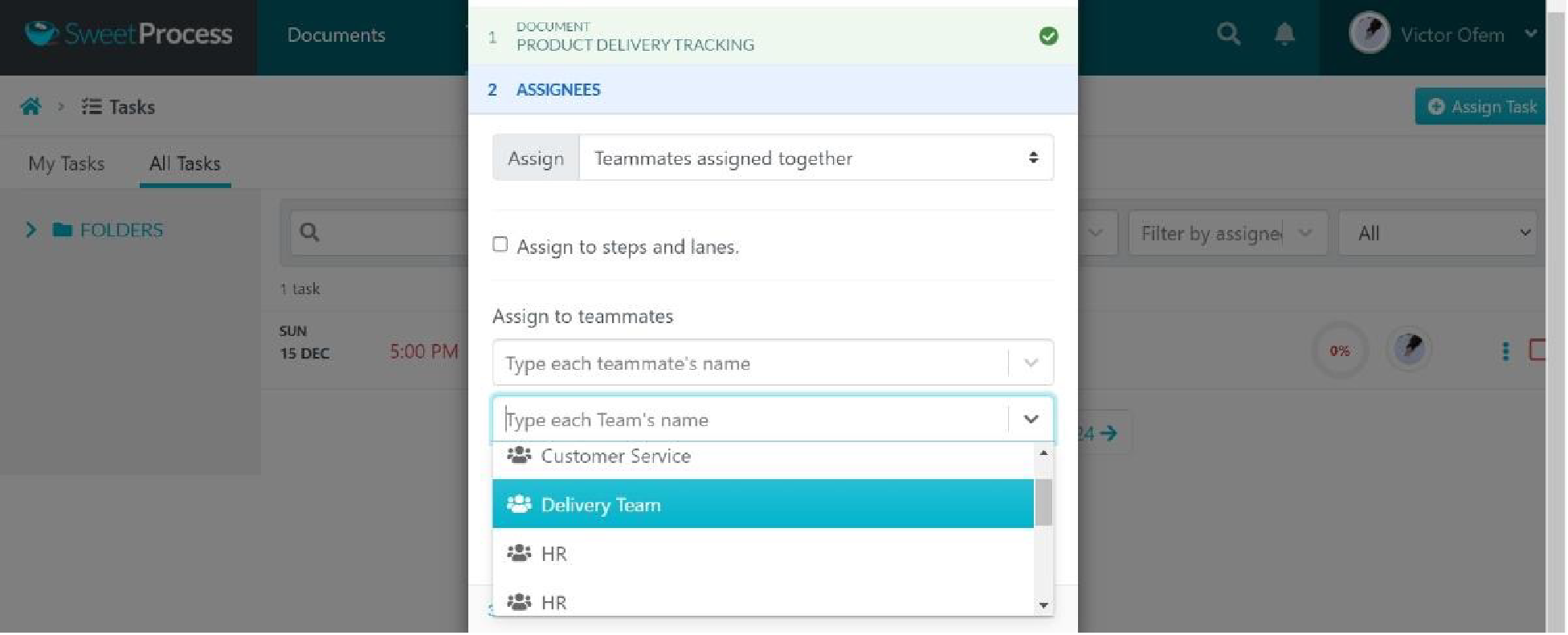
Select the frequency of the task repetition.

Click “Save,” and you can go to the “Tasks” menu to see the list of all the tasks you have.
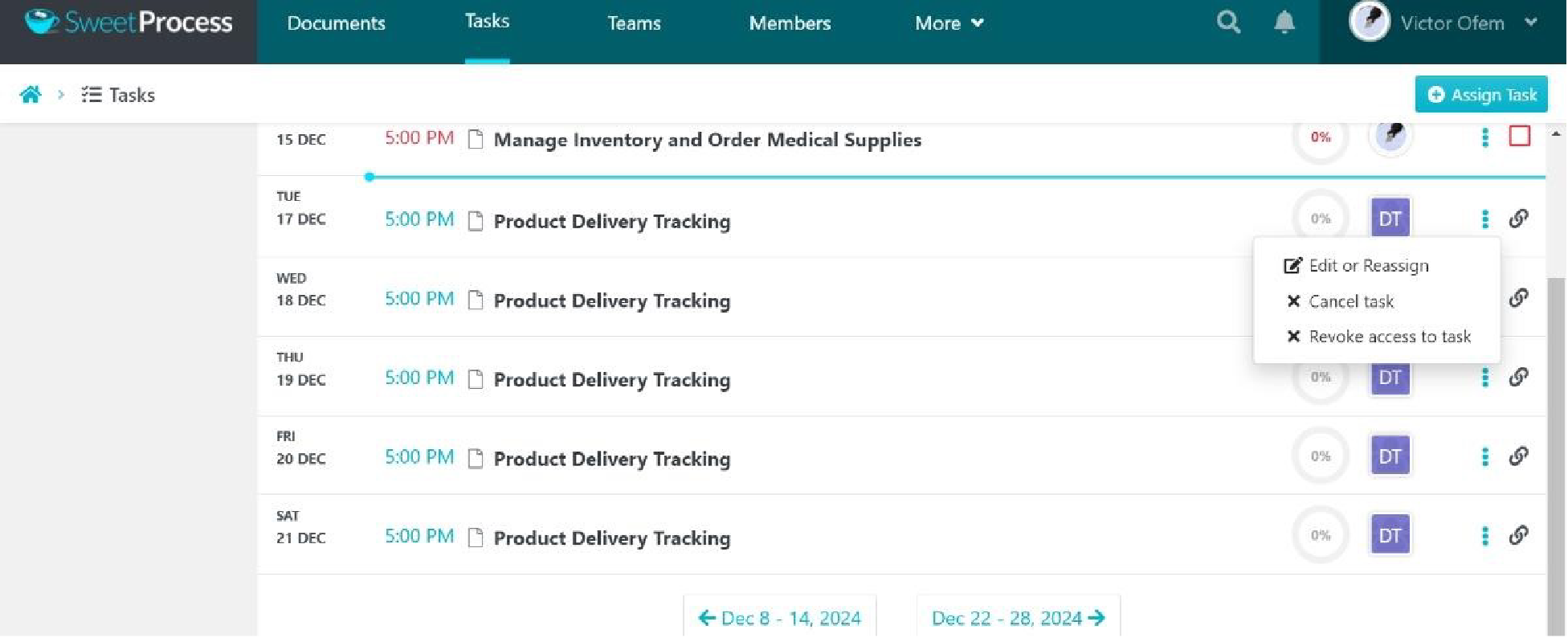
Turn Procedures and Processes Into Actionable Tasks
Go to the “Tasks” section and click on “Assign Tasks.”

Then, select from any of your existing procedures or processes. For instance, Product Delivery Tracking.

Type the name of the team member you want to handle it and click on “Next.”

Set a deadline for the task and save.

Manage Your Team Effectively and Seamlessly
To manage your team effectively, always create knowledge bases for their frequently asked questions.
You can use the main menu dashboard to create and assign tasks to your team members.
You can also set due dates for projects.

If you want to delete, share, download, export, or move a file to a recycle bin, simply tap on the three dots of any article, and the options will appear for you to select.
Manage Procedures, Processes, and Policies
SweetProcess makes this whole process straightforward.
If you want to see a procedure, policy, or process, log in to your dashboard and you will see a menu button for each of them.

If you can’t find a procedure, process, or policy, you can click on the “More” tab to drop down the remaining options. Or use the search bar to type the name of any procedure, policy, or process document so you can select it.
Build a Quiz to Assess Your Team’s Grasp of Company Policies, Processes, and Procedures
You can use the quiz tool to assess an employee’s understanding of your company’s policies, processes, and procedures.
To create a quiz, go to the “More” menu and click on “Quizzes.”

Click on “Create Quiz” and give it a title.

To set it correctly, add a time range for the quiz so you can see when they finish.

Set up Teams to Reflect Your Company Culture
Go to “Teams” and click on “Create Team.”

Give it a name that reflects a unit under your business. It could be “Delivery Team,” “Customer Support Team,” etc.

Then, select a specific procedure that explains the role they will play.
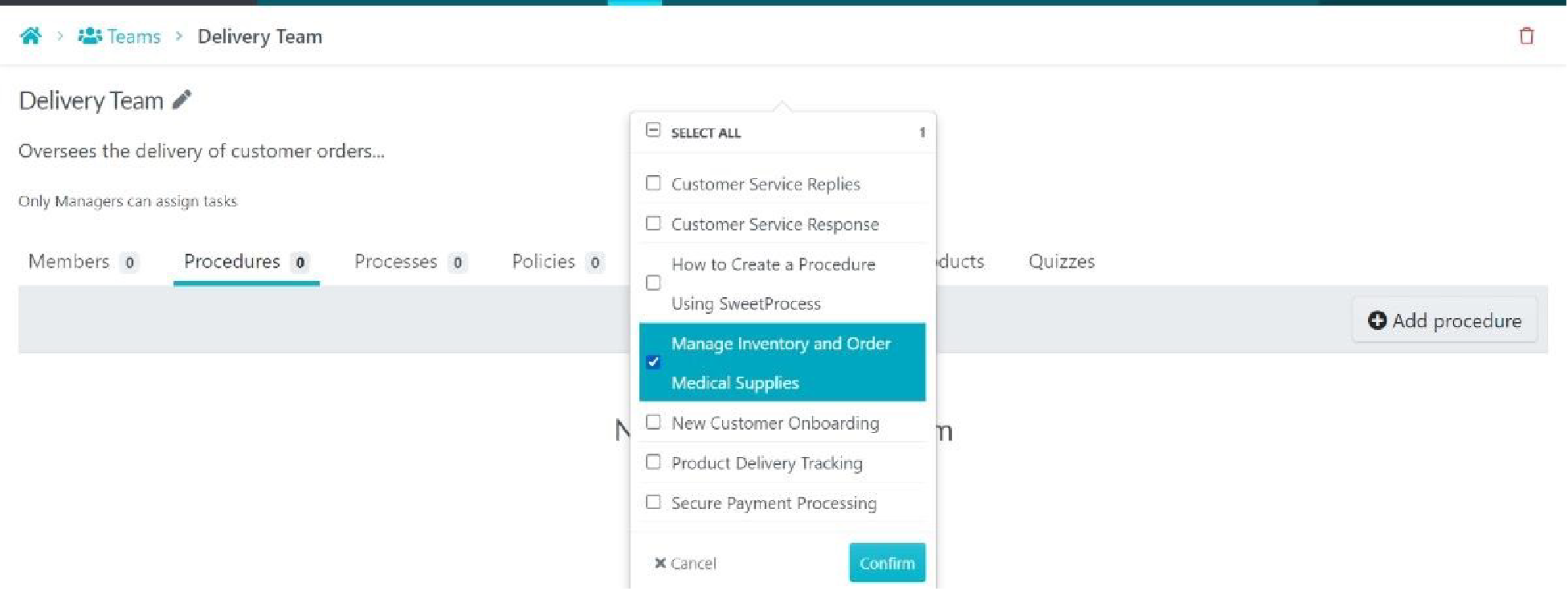
Click confirm and approve it.
Turn Existing Procedures and Policies Into a Beautiful Knowledge Base
Go to the “More” tab and select “Knowledge Bases.”

Click on “Create Knowledge Base.”

Give it a title and write the article.

Select a theme that matches your brand colors (if any).
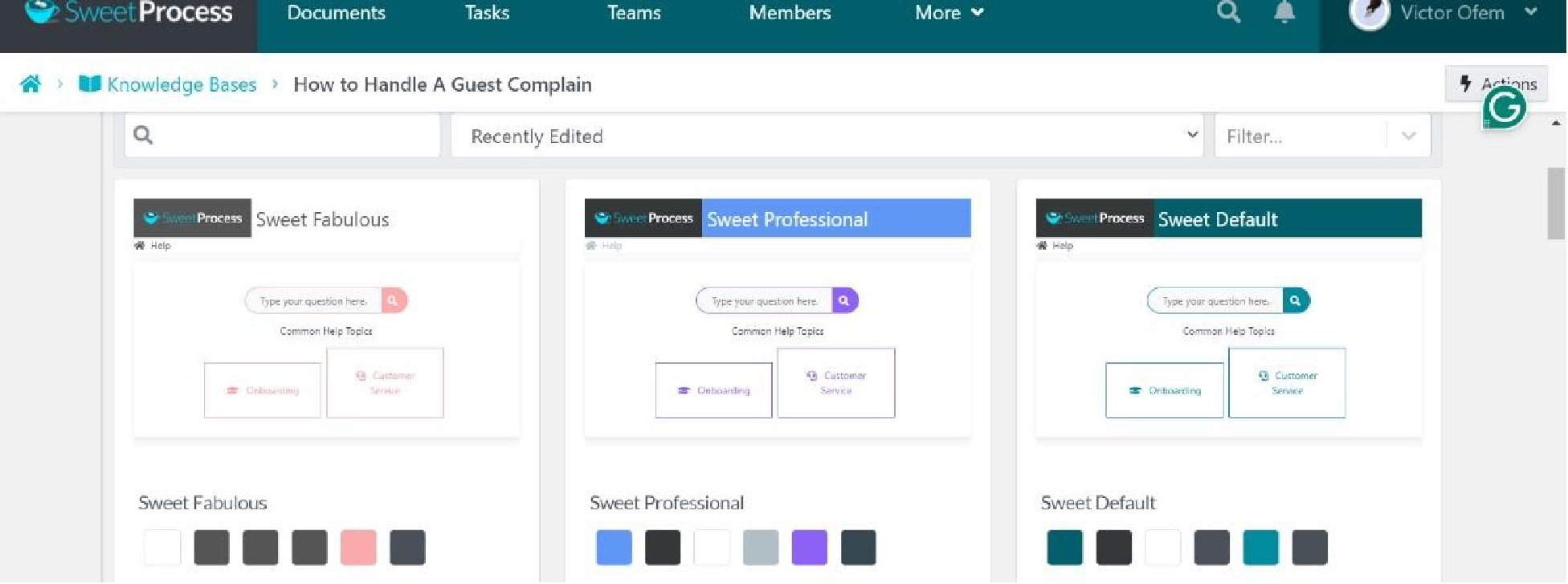
Once you’re done, click on “Approve” to save it.
And that’s how SweetProcess makes enhancing your employee’s productivity easy.
Take, for instance, the CEO of Optiable, Craig Bayer, who runs document management software for lawyers and had an urgent need to document processes.
At first, he tried to fix this by manually documenting their processes, but it was still a hard nut to crack. Micromanaging their employees took up a chunk of his time at the expense of other important tasks.
Luckily, he opted for SweetProcess, and their employees’ productivity has gone up since they started using SweetProcess, even though they handle more work than before.
“Now, everything is a lot more relaxed even though we are doing more work than we were doing before. Once you have everything on a list, it’s just a lot easier to work rather than not knowing what’s on that list. We don’t have that uncertainty anymore.”
Jamie Ramsden, business intelligence and lean Six Sigma champion at Turkstra Lumber, had a similar experience. His team performed tasks in different ways, creating inconsistency across the company despite their expertise.
He asked an MBA intern working with him at the time to use his “smart brain” to find a reliable tool to help speed up their workflow.
Initially, Jamie thought SweetProcess would be challenging to use. However, he was pleasantly surprised to find it easy to use. With SweetProcess, Jamie was able to simplify tasks, reduce inconsistencies, and boost efficiency.
Now, with SweetProcess, Turkstra Lumber’s operations have become smoother, and employee efficiency has increased. Jamie credits SweetProcess as a game-changer for the organization, transforming how it works.
According to Jamie, “Because I didn’t understand what the project was, I thought I needed something like a better version of Excel that would just be easier to use to record things. But recording processes with SweetProcess is the easy part.”
“The thing that caught my attention first was just something simple and visual: SweetProcess automatically makes you a little flowchart as you enter your steps for any process. People understand things in different ways, and a lot of our staff really like it if they can get a visual representation immediately,” he added.
7 Employee Productivity Tools You Can Use in The Workplace
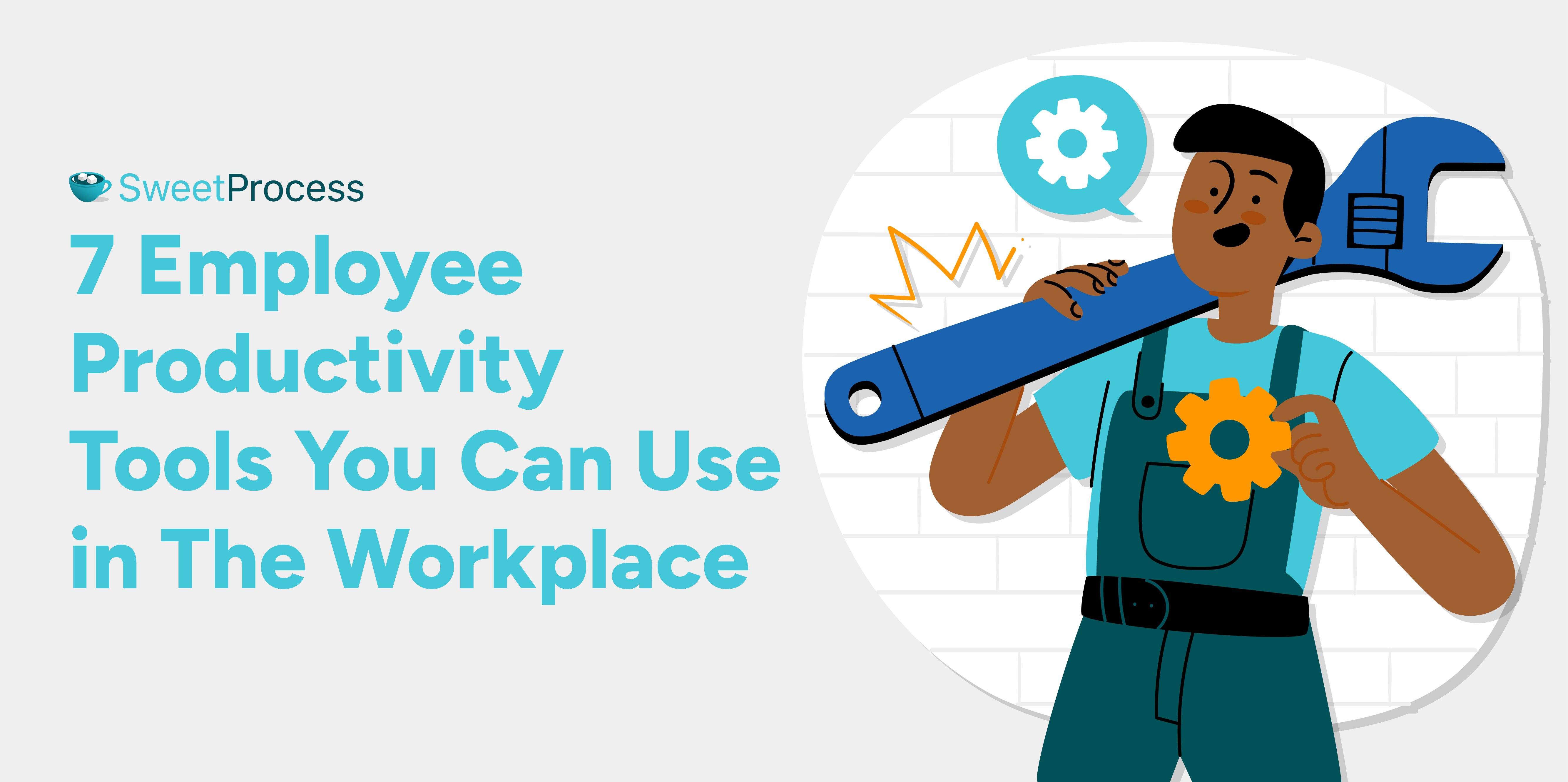
Boosting employee productivity is important for companies to grow and succeed. Below are seven categories of productivity apps that can help your business:
Employee Monitoring Tools
These tools help you monitor your staff activity, work schedule, and performance. They provide details into how employees spend their time and find areas for improvement.
They include:
- Hubstaff
- Toggl
- SweetProcess
- Hourly
Time-Tracking Tools
They are used to keep tabs on individual employee’s work schedules and performance, especially when there’s a need to assess their contribution. Some of these tools are:
- Any.do
- SweetProcess
- Todoist
- Monday
Project Management Tools
These software tools help team members easily share ideas, organize workflows, assign and track tasks, or even set project due dates. Examples include:
- Trello
- Asana
- SweetProcess
- Basecamp
Employee Accountability Tools
Companies often use accountability tools to review performance and encourage staff dedication and commitment to daily routines. This promotes transparency and ensures that every staff member is active.
Some examples are:
- SweetProcess
- Toggl Track
- Time Doctor
- Hubstaff
Behavioral Analytics Tools
Managers often run these apps to get insights into why and how employees behave the way they do and to dig out reasons why they hold certain sentiments so they can refine their policies and workplace culture to boost staff productivity and morale. Some examples include:
- ActivTrak
- SweetProcess
- Insightful
- ClickUp
Communication and Collaboration Tools
Have anything to discuss with your teammates? These tools can help you chat them up and share videos, audio, images, PDFs, and feedback on any team project. You can use it remotely to save and boost productivity. They include:
- Microsoft Teams
- Discord
- Slack
- SweetProcess
Automation and AI-based Tools
To automate recurring tasks, you can use these tools to free up time to focus on revenue-generating activities for your company. Some of them include:
- SweetProcess
- Zapier
- PeopleDoc
- Workable
While each type of tool listed above has a decent alternative, it’s ideal to opt for an all-in-one software with AI features that enable tracking tasks, monitoring staff, logging work time, collaborating with team members, and promoting accountability across the board.
That’s why SweetProcess comes in handy. You can sign up for a 14-day free trial and see how it can speed up your staff productivity today. And yes, there’s no need to add a credit card to begin.
How to Measure Employee Productivity
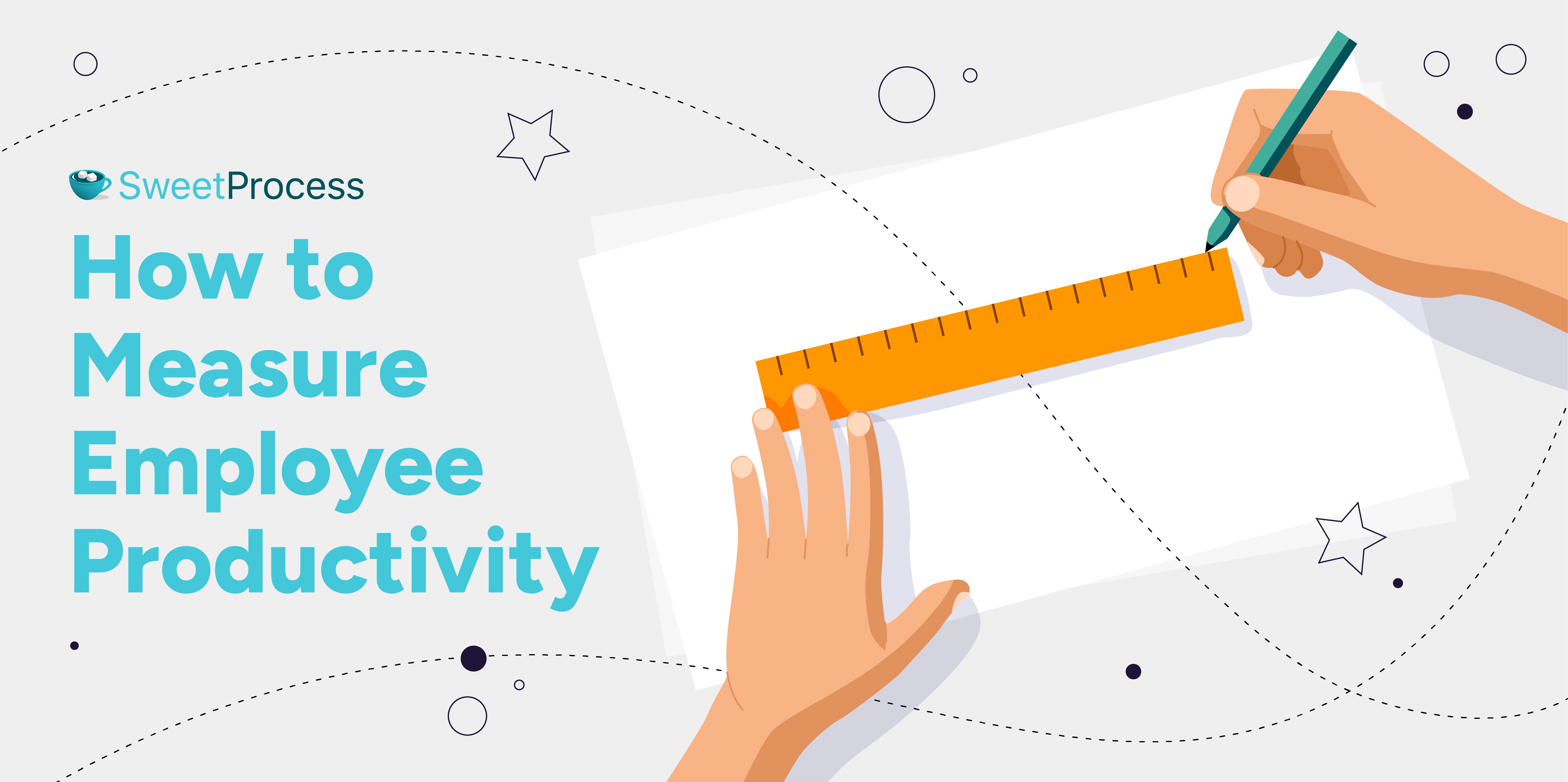
It’s easy to measure the staff productivity. Let’s walk you through some key steps:
Measure the Work Completed
Check the number and quality of duties your staff have done. This involves tracking progress bars, task completion rate, and undone projects. That is, you review the quantity and the quality of tasks completed by employees. For instance, Toyota’s production system measures productivity by checking the number of cars produced, product defects, and cycle time to identify areas needing improvement.
Measure the Overall Profit
Assess how individual employee efforts add up to the whole income and profit margin you have generated. This includes checking their sales rate, performance, customer service delivery, and production cost-reducing initiatives. McDonald’s, for instance, measures this through the order fulfillment rate, stockout rate, and timely delivery rate to learn more about staff performance.
Measure the Goals Achieved
How many goal boxes have been ticked? You also need to evaluate every employee’s progress in hitting their performance indicators or tasks. Just like Amazon’s performance management system, it sets clear goals and objectives for team members and tracks progress through regular check-ins and feedback sessions. SweetProcess can easily help you set up a system similar to the task manager and due dates feature.
Measure the Output Quality
Some workers may rush to complete tasks without paying attention to quality output. You need to check whether their output has fewer errors, and if they really pay attention to details or if they just do poor quality products and services.
In Amazon, they have a quality control process that runs constant audits and checks to ensure products meet quality standards. When you have a system like this in place, your staff sees a pressing need to produce high-quality work.
Measure the Timeline or Time Spent
Of course, time is of the essence, and you need to look out for those who are too slow to act. Their delay and missed deadlines can reduce customer satisfaction and slow down your overall productivity and sales.
That’s why the SweetProcess tasks tracker is essential to help you set due dates, check their sign in or off activities, and monitor team projects, to know exactly what could be a bottleneck in your workflow so you can make adjustments. Sign up for a 14-day free trial to see how it works in real-time.
7 Factors That Influence Employee Productivity

Let’s go over these seven key factors that affect employee productivity so you can leverage them to drive business growth:
Employee Well-being
It’s hard for a mentally or physically unhealthy employee to give out their best. A healthy staff will typically be more engaged and willing to start and finish tasks within deadlines. Not only that, they are more likely to do quality work. Managers can support this by providing access to perks like insurance health care plans to promote employee wellness and work-life balance.
Management Relationships
The quality of relationships you have with your employees has a significant impact on productivity. As a manager, you can build trust and rapport with your employees by being approachable and through empathy and rewards. When an employee feels free to approach you as their manager with questions, or concerns, it will make them feel comfortable to give their best.
Company Culture
As a manager, you can create a positive work environment and inclusive company culture by simply promoting equity, diversity, and inclusion, recognizing and celebrating employee achievements, and encouraging feedback. By default, the respect and sense of community will further boost employee engagement and dedication to work.
Workplace Environment
A well-arranged, comfortable, and equipped workspace can improve focus and help people efficiently carry out their duties. Even negligible add-ons like lighting, temperature, and noise levels can prevent noise, improve focus, and speed up operations. You can also make it more comfortable with ergonomic furniture, ventilation, and the necessary tools and equipment.
Diversity
A diverse and inclusive workplace welcomes different viewpoints and ideologies, leading to innovation and creativity. When employees feel included and valued, they are more likely to contribute their best work. This can be utilized by recruiting talent from a wide range of demographics and creating fun times to celebrate cultures and diversity.
Staff Training
Companies that grow faster imbibe the culture of continuous improvement. When your staff has the right knowledge needed to play their roles, the workload gets completed faster. Plus, it’s easy to streamline the whole process with an employee training tool like SweetProcess.
You don’t have to teach the same thing repeatedly. You can even use SweetProcess for 14 days free to see how it simplifies staff training. No credit card is required.
Equipment and Technology
Access to modern, reliable, and user-friendly equipment and technology is crucial for employee productivity. When employees have the right tools and resources, they can work efficiently and effectively. Companies should invest in the latest technology such as SweetProcess, which has a SweetAI feature that spits out SOPs in seconds. With this, you get to streamline processes and enhance employee productivity.
Unlock Your Team’s Potential Using SweetProcess

As a business owner or manager, your business grows bigger with happy customers and profit based on how well you harness your resources and staff strength to do productive work.
But it’s hard to pull it off manually. However, the whole process can be made seamless if you use the right approach and suitable tool for your business.
When you have handy software like SweetProcess, you no longer have to manually manage your workflow.
There’s a feature that helps you onboard new hires, build and manage SOPs, collaborate with teammates, generate SOPs with AI, assign and keep tabs on tasks, set up learning quizzes, create knowledge bases, and measure your staff productivity so you can have more free time to drive profit and do the things you love.
